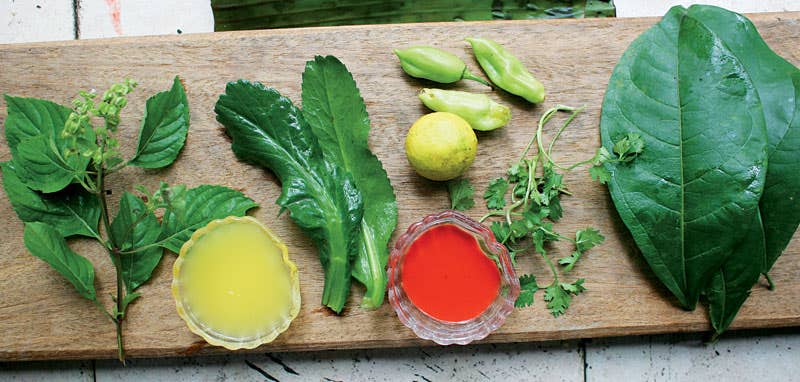
Flavors of the Amazon
Shopping for the recipes in this issue's story on Marajo, Brazil ("Passage to the Amazon,"), our test kitchen staff was able to find all of the necessary ingredients—or close analogues that make fine substitutes—at Asian, Latin American, and Caribbean grocery stores and websites. Having fallen in love with the bold, wild flavors of this part of Brazil, it's great to know that I can re-create them here at home.
Alfavaca (farthest left), a kind of basil used widely on Marajo, has a lemony, grassy flavor; we found that both Thai and lemon basil made perfect substitutes. Culantro (flat leaves, third from left), widely available at Latin American markets, is a favorite herb on Marajo, where it's used in fish, chicken, and duck dishes, as well as virtually every stewed dish, usually in tandem with alfavaca and cilantro (second from right), another herb that grows in abundance on the island. A riot of chiles lend flavor and heat to Marajoaran cooking: The perfumed, sweet, slender, light-green pepper known as murupi or pimenta de cheiro doce ("sweet-smelling chile;" top of board) is widely used in savory dishes, typically sauteed along with garlic and onion to create a flavorful base for sauces for meat and fish. You can substitute Italian frying peppers (available from The Chile Woman) for the pimenta de cheiro doce. Sweet limao rosa (pink limes; below the chile) are juiced to create a tangy marinade for fish and crabs; key limes (available from Melissa's) have a similar acidity and are a good proxy. Cadmium-red annatto (often sold in this country as achiote) is mixed with water to make urucum liquido (liquid annatto; in the right bowl), which imparts a peppery, earthy flavor to everything from beans and rice to sumptuous cheese and pasta casseroles. Look for whole annatto seeds, available from the Great American Spice Company, or in Latin American and Caribbean grocery stores and pulverize them in a spice grinder before using. Avoid prepared achiote pastes, which often include other ingredients that interfere with the flavor of the annatto, like oregano. Little-known outside of the Amazon, cipo d'alho, or garlic bush (Mansoa alliacea; farthest right ), has broad leaves that smell like bacon. You won't find the leaves at grocery stores, but tropical plant stores (such as Top Tropicals) sell the seeds and plants. Of course, for some things, you still have to travel. One of the most ancient ingredients in the Amazon is tucupi (in the left bowl), made from the cooked juice of fermented cassava that's a by-product of the elaborate process for making cassava meal. Ranging in color from pale yellow to deep goldenrod with a flavor that's pure umami, the liquid is enriched with chiles and added to a variety of fish, shrimp, and poultry dishes, and is also used as a base for fiery, chile-spiked stews.
Keep Reading
Continue to Next Story










